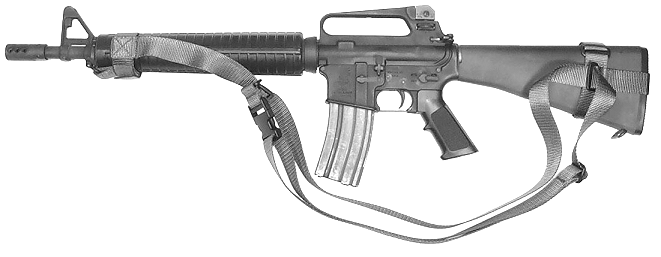|
Marksmanship
Main
Page
|
In addition to the three
elements of a good shooting position, there are seven factors that are
common to all shooting positions. The seven factors affect your ability to
hold the rifle steady, maintain sight alignment, and control the trigger.
The way these factors are applied differs slightly for each position, but
the principles of each factor remain the same. It is important to become
familiar with these common factors and how they apply to each shooting
position.
Note: The following procedures are written for right-handed shooter;
left-handed shooters should reverse directions as needed.
- Left Hand
- In all positions it is desirable that the hand
guard of the rifle rest in the "V" formed by the thumb and index finger
of the left hand. The left wrist is straight with the rifle resting
across the heel of the hand. The left elbow should be positioned under
the rifle to create bone support and a consistent resistance to recoil.
The fingers can curl around the hand guard, but should apply only the
minimum amount of pressure to prevent the hand from slipping on the hand
guard, the configuration of the body in the different positions will
affect the placement of the left hand along the hand guard.
- Rifle Butt in the Pocket of the
Shoulder
- Place the rifle butt firmly into the pocket
formed in the right shoulder. This reduces the effect of recoil, helps
steady the rifle, and prevents the rifle butt from slipping during
firing. Although the exact placement of the rifle butt in the shoulder
will change from position to position, consistent placement of the rifle
butt in the shoulder pocket within each position is essential to firing
tight shot groups and maintaining a true zero.
- Grip of the Right Hand
- The pistol grip or stock is grasped firmly with
the right hand, and the forefinger is placed on the trigger with the
thumb and remaining fingers wrapped around the pistol grip or stock.
Firm rearward pressure should be exerted to help keep the rifle butt
firmly in the shoulder, reducing the effects of recoil. The trigger
finger should be placed naturally on the trigger and care should be
taken to ensure that the trigger finger can move independently without
dragging on the side of the receiver. A proper grip allows the trigger
to be moved straight to the rear without disturbing sight alignment.
- Right Elbow
- The right elbow should be positioned naturally
to provide balance to the position. If the elbow is correctly
positioned, it helps to form the pocket in the right shoulder where the
rifle butt rests. The exact placement of the elbow varies with each
shooting position but should remain consistent from shot to shot,
ensuring the resistance to recoil remains constant.
- Stock Weld
- The placement of the cheek against the stock
should remain firm and consistent from shot to shot. Consistency of
stock weld is achieved through proper placement of the rifle butt in the
pocket of the shoulder. A firm contact between the cheek and the stock
enables the head and rifle to recoil as a single unit. This provides
quick recovery between rapid fire shots, keeps the aiming eye centered
in the rear sight aperture, and prevents the head from bouncing off the
stock during recoil. Eye relief is the distance of the eye from the rear
sight aperture. A correct shooting position will determine the distance
between the eye and the rear sight. Although the distance from the rear
sight to the eye varies between positions, consistent eye relief within
each position is essential to accurate shooting.
- Breathing
- Breathing causes movement of the chest and a
corresponding movement in the rifle and its sights. To minimize this
movement and the effect it has on your aim, learn to control your
breathing and extend your natural respiratory pause for a few seconds
during the final aiming and firing process. When firing rapid
fire shots, it may be necessary to take small short breaths to produce a
respiratory pause between each shot. The respiratory : pauses help to
maintain natural point of aim, however, holding your breath too long may
lessen your ability to maintain focus on the sights.
- Relaxation
|

